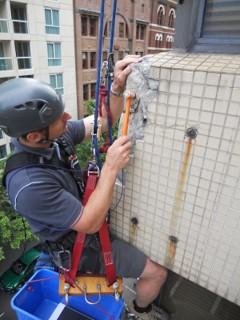Case 1
- Introduction
- Causes of Defects
- Good Practices
- Standards
- Maintenance and Diagnostics
- Remedial
- Similar Cases
- References
Maintenance and Diagnostics
Repair of spalled surfaces should be done by cutting loose and flaking material to the base and replacing with new bricks or blocks or made with layers of mortar. Consolidate weathered masonry (to stabilise the degradation) in accordance with SS 509-2, BS 8221-2 or equivalent. Maintenance and repair of renders should be carried out in reference to BS EN 13914-1, ASTM C926-20 or equivalent. Attend to cracks on the façade surface promptly to control moisture ingress in order to avoid delamination. Re-tile deboned tiles or over-clad existing façade to remedy delamination (see also BCA’s guidelines for periodic structural inspection of existing buildings).
Regular inspection of once a year, is necessary to monitor the development of tile debonding process to avoid any accident caused by dropping off.
Cleaning method: High-pressure water jet or using a non-toxic and mild acidic-based solution.
Diagnostics of Defect (see also NDT)
Hammer Tapping Test
Tapping test may be used to detect hollowness, delamination, spalled or debonded plaster.by listening to the ‘void’ sound.


Fibrescope / Borescope
A fibrescope or a flexible borescope is a flexible optical inspection device that consists of fibre optic bundles with an eyepiece at one end and a lens at the other. A fibrescope usually comes in two bundles: (i) a fibre optic light bundle that is for illuminating the object to be investigated, and (ii) a fibre optic image bundle to relay the image to the eyepiece. It allows a direct visual inspection for an otherwise inaccessible part, as observations of remote, difficult-to-reach areas can be made through a video monitor with high-resolution images. The flexible fibres allow it to be manoevred in hard-to-reach or inaccessible areas.
It is often used to verify findings from other tests, such as infrared thermography or impact-echo testing.
Common applications include:
– Inspection of connecting condition behind the external cladding wall of a building.
– Inspection of defects on concrete surface(s) in a deep and narrow gap.
– Determination of corrosion condition of steel tendon(s) inside post-tensioning ducts of pre-stressed structural member(s).
– Investigation of service pipes, ducts and other inaccessible areas.



Thermography can be used to identify the position of cracks. A range of crack widths, representing mechanical damage, has been induced under controlled laboratory conditions. The method is based on the characteristics of heat flow phenomenon, in a conductive medium of specific geometry, which is intended to model predetermined boundary conditions.

The tiles’ key, the substrate’s condition and extent of preparation, evidence of external staining, evidence of real movement joints, the adhesive type and original specification and evidence of structural movement.
Sound tests were conducted on the defective areas. It involves knocking on the tile surface with a metallic tool. A hollow sound is usually an indication of poor bonding.
Pull-off Test can be carried out to determine the adhesive strength of the tiles with its substrate.

